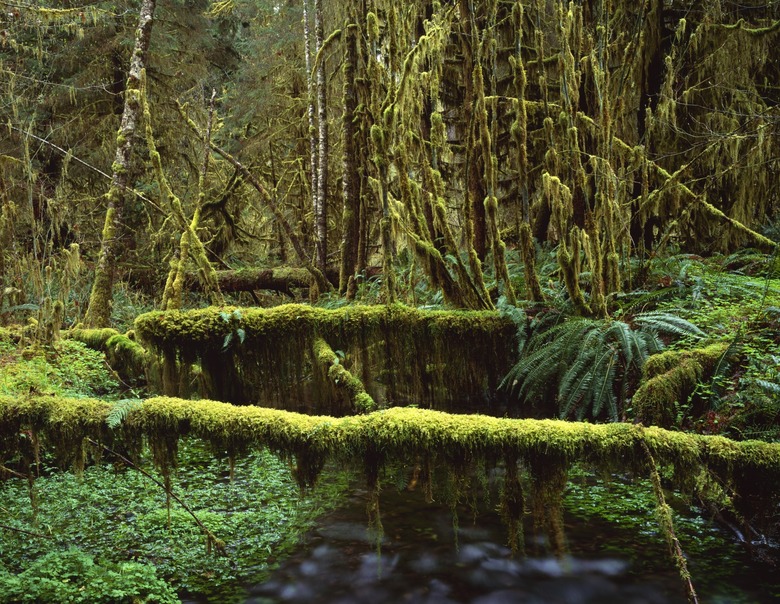List Of Tropical Rainforest Plants
The tropical rainforest is one of the most diverse and biologically rich biomes on the planet. In this unique environment, warm temperatures and high annual rainfall form an ideal environment for tropical rainforest plant species to thrive. However, challenges like low light penetration beneath the canopy and nutrient-poor soil require special adaptations among plant species. Trees, vines, aquatic plants, flowers and other varieties of plant life all compete to fill their niche in the rainforest, some more successfully than others.
Rainforest Resources
The rainforest is a unique environment that fosters explosive levels of plant diversity and growth. Over half of the world's discovered plant and animal species are found in tropical rainforests. A rainforest has an average rainfall of 50 to 260 inches per year, and remains warm year round. Humidity stays between 77% and 88%, and temperatures rarely drop below 68 degrees Fahrenheit. Scientists estimate that rainforest plants provide up to 40% of the Earth's oxygen, yet the rainforest biome only covers 6% of the Earth's surface.
Towering Trees
Trees make up 70% of tropical rainforest plant species, and jungle tree species dominate the ecosystem's structure. In South America, 100 to 300 unique species of trees were found in just one hectare of rainforest. Trees in the rainforest don't branch out until they've reached a height of 100 feet or more, and form a dense canopy above the rest of the ecosystem that obstructs light before it reaches the forest floor.
Jungle tree species often have a buttress root system, where roots grow outward to support the tree, because the sandy, loose soil of the rainforest provides a poor foundation. Trees give off moisture through transpiration, and the moisture provided in this way can account for up to 50% of the precipitation in a rainforest, keeping the air beneath the canopy constantly humid.
Winding Vines
Vines and lianas, or woody vines, are a key part of the rainforest's composition. These freeloading species use the woody trunks of trees as a staircase to the canopy, where they compete with trees for resources like sunlight and water. Vines and lianas also provide a network of connections between trees for animals to move around, and in the dry season they provide food to other organisms. Vines and lianas can, unfortunately, outcompete a tree for resources, by strangling it or preventing further growth.
Understory
Aside from young trees that will eventually grow tall and reach the canopy layer, understory plants grow to around 12 feet tall. The understory is full of young trees and palms, shrubs, herbaceous plants and ferns. These plants absorb nearly all the remaining sunlight in this dim environment, only leaving 2% to reach the forest floor below where leaves decompose.
Philodendrons, zebra plants (Aphelandra squarrosa) and prayer plants (Maranta leuconeura) are three tropical rainforest plant species that are also common household plants. These types of plants grow well indoors because of their adaptations to low light from the rainforest understory.
Many understory plants have adapted bright white flowers with strong scents to help attract the rich biodiversity of animal pollinators in this area of the rainforest. These flowers grow directly on the sides of tree trunks and are easily visible to pollinators passing by despite the low lighting.
A Variety of Life
Plants in the rainforest come in all varieties. Many rainforests have large freshwater systems where aquatic plants can thrive, providing ecosystems for fish, eels, and other life along rivers, streams and lakes.
Bromeliads are a unique family of tropical rainforest plant species that can hold water in the center of their cone-shaped leaves, sometimes several gallons at a time. A familiar species of bromeliad is the pineapple (Ananas comosus) with its sweet, yellow fruit – the only type of bromeliad used for food by humans.
Orchids, an abundant flower variety, grow throughout the rainforest, even on the branches of trees. Microbial plants and fungi, called saprophytes, work to capture nutrients before they can be washed away by heavy rainfall.
References
- Blue Planet Biomes: Rainforest Biome
- Wet Tropics Management Authority: Aquatic Ecosystems
- Live Science: Tree Stranglers: Vines Overtaking Tropical Forests
- MongaBay: Vines and Lianas
- DK Find Out: Forest Floor Facts
- Smithsonian Tropical Research Institute: Rainforests – Understory
- MongaBay: Floating Meadows in the Rainforest
Cite This Article
MLA
Dilthey, Max Roman. "List Of Tropical Rainforest Plants" sciencing.com, https://www.sciencing.com/list-tropical-rainforest-plants-7433910/. 30 September 2021.
APA
Dilthey, Max Roman. (2021, September 30). List Of Tropical Rainforest Plants. sciencing.com. Retrieved from https://www.sciencing.com/list-tropical-rainforest-plants-7433910/
Chicago
Dilthey, Max Roman. List Of Tropical Rainforest Plants last modified March 24, 2022. https://www.sciencing.com/list-tropical-rainforest-plants-7433910/
